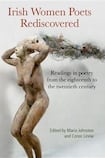
Field Day’s infamous omission of female Irish poets in its 1990 anthology is often cited as emblematic of an enduringly male-dominated Irish poetic culture. Now, a new essay collection aims to shine light on overlooked Irish women poets from the late modern period. Each essay takes one poet as its subject, closely analysing an extract of her work and exploring what is known of its author’s life.
Such an endeavour is not entirely unproblematic, as the collection’s introduction notes. Does creating “women’s poetry” as a distinct category provide a necessary alternative to a stubbornly masculine canon, or do such efforts further constrain already marginalised literature?
The illuminating readings offered here offset any simplistic reductions. We encounter a diverse mix of individuals, each with their own distinctive style, background and concerns. Some, such as Lola Ridge and Angela Greene, were popular during their lifetime but neglected by later readers; others established private presses when they were unsuccessful via conventional publishing routes (Blanaid Salkeld founded the Gayfield Press in 1937); others still were never published during their lifetime, such as Dorothea Herbert, whose work was preserved in private notebooks.
What’s often most interesting is understanding why such obviously skilled writers were erased from the record. We learn how Ridge’s leftism and experimentalism ensured her decline until the 21st century; how figures such as Lynda Moran suffered from an industry of overwhelmingly male-owned presses, which is largely unchanged today.
And though these poets are various, common themes emerge. Domestic labour, and its hindrance to poetry, preoccupies several, as does politics: Dora Sigerson Shorter’s early death was attributed by many to grief at the events of the Easter Rising, while Charlotte Grace O’Brien’s advocacy for poor Irish emigrants prompted a formal review by the British government.
Many of these poets produced highly allusive, literary work and sustained fruitful working relationships with their male contemporaries, even if they are now remembered as little more than correspondents or muses.
Importantly, this collection wears its experts’ knowledge lightly, so that its fruits are accessible to any interested reader. It provides a thoughtful survey of writers who are interesting and important in their own right; whose time, as Seán Hewitt writes of Emily Lawless, “is with us”.












